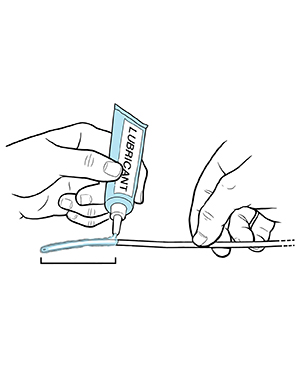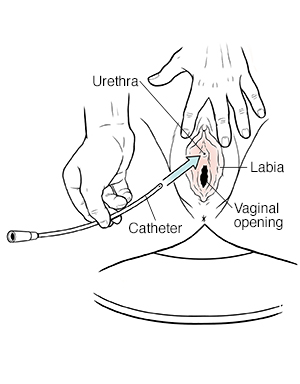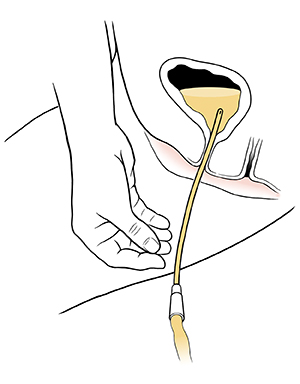Discharge Instructions: Self-Catheterization for Women
Your healthcare provider has prescribed self-catheterization for you because you are having trouble urinating naturally. This problem can be caused by injury, disease, infection, recent surgery (especially urinary incontinence or prolapse procedures), hysterectomy, or other conditions.
Many people urinate by self-catheterization (also called intermittent catheterization). Self-catheterization simply means inserting a clean, thin, flexible tube (catheter) into the bladder to empty urine. This helps you empty your bladder when it won’t empty by itself or won't empty all the way. You were shown in the hospital how to do this procedure. The steps below should help you remember how to do it correctly.
Gather your supplies
You will need the following:
Get ready
-
Wash your hands and your genital area. Use warm soapy water. You can also use a moist towelette. As always, wash from front to back.
-
Lubricate the catheter with the water-soluble lubricating jelly.
 |
| Lubricate catheter. |
Empty your bladder
-
Spread the labia (the lips or folds at the opening of your vagina). Use a mirror or your index finger to find the urethra (urinary tract opening).
-
Slowly insert the catheter into your urethra. If it doesn’t go in, take a deep breath and bear down as if trying to urinate.
-
If you feel a sharp pain, remove the catheter and try again.
-
Empty your bladder.
-
When the urine starts to flow, stop inserting the catheter.
-
When the urine stops flowing, slowly remove the catheter.
 |
| Insert catheter. |
 |
| Empty urine. |
Catheter care
If you use a disposable catheter, use a new one each time you empty your bladder. Throw the catheter away when you’re done. If your catheters are reusable, do the following after each use:
-
Wash your hands with soap and clean, running water.
-
Clean the catheter with soap and warm water.
-
Rinse the catheter, making sure there is no soap left inside or on it.
-
Dry the outside of the catheter.
-
Store the catheter in a clean, dry container, such as a plastic bag that seals at the top.
-
Throw away a catheter if the plastic looks cloudy.
-
Wash your hands again. If you used a basin, wash it out.
Follow-up care
Follow up with your healthcare provider, or as directed.
When to call your healthcare provider
Call your healthcare provider or get medical care right away if you have any of the following:
-
Fever of 100.4° F ( 38°C ) or higher, or as advised by your healthcare provider
-
Chills
-
Burning in the urinary tract or pubic area
-
Nausea and vomiting
-
Aching in the lower back
-
Sand-like material (sediment) or mucus in the urine
-
Cloudy urine
-
Bloody (pink or red) or bad-smelling urine
Online Medical Reviewer:
Marc Greenstein MD
Online Medical Reviewer:
Melinda Murray Ratini DO
Online Medical Reviewer:
Rita Sather RN
Date Last Reviewed:
8/1/2024
© 2000-2024 The StayWell Company, LLC. All rights reserved. This information is not intended as a substitute for professional medical care. Always follow your healthcare professional's instructions.